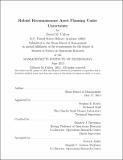| dc.contributor.advisor | Dimitris J. Bertsimas. | en_US |
| dc.contributor.author | Culver, David M. (David Martin) | en_US |
| dc.contributor.other | Massachusetts Institute of Technology. Operations Research Center. | en_US |
| dc.date.accessioned | 2014-02-10T13:32:39Z | |
| dc.date.available | 2014-02-10T13:32:39Z | |
| dc.date.issued | 2013 | en_US |
| dc.identifier.uri | http://hdl.handle.net/1721.1/84714 | |
| dc.description | Thesis (S.M.)--Massachusetts Institute of Technology, Sloan School of Management, Operations Research Center, 2013. | en_US |
| dc.description | This electronic version was submitted by the student author. The certified thesis is available in the Institute Archives and Special Collections. | en_US |
| dc.description | Cataloged from student-submitted PDF version of thesis. | en_US |
| dc.description | Includes bibliographical references (pages 105-107). | en_US |
| dc.description.abstract | This thesis considers the tactical reconnaissance asset allocation problem in military operations. Specifically this thesis presents methods to optimize, under uncertain conditions, tactical reconnaissance asset allocation in order to maximize, within acceptable levels of asset risk exposure, the expected total information collection value. We propose a deterministic integer optimization formulation and two robust mixed-integer optimization extensions to address this problem. Robustness is applied to our model using both polyhedral and ellipsoidal uncertainty sets resulting in tractable mixed integer linear and second order cone problems. We show through experimentation that robust optimization leads to overall improvements in solution quality compared to non-robust and typical human generated plans. Additionally we show that by using our robust models, military planners can ensure better solution feasibility compared to non-robust planning methods even if they seriously misjudge their knowledge of the enemy and the battlefield. We also compare the trade-offs of using polyhedral and ellipsoidal uncertainty sets. In our tests our model using ellipsoidal uncertainty sets provided better quality solutions at a cost of longer average solution times to that of the polyhedral uncertainty set model. Lastly we outline a special case of our models that allows us to improve solution time at the cost of some solution quality. | en_US |
| dc.description.statementofresponsibility | by David M. Culver. | en_US |
| dc.format.extent | 107 pages | en_US |
| dc.language.iso | eng | en_US |
| dc.publisher | Massachusetts Institute of Technology | en_US |
| dc.rights | M.I.T. theses are protected by
copyright. They may be viewed from this source for any purpose, but
reproduction or distribution in any format is prohibited without written
permission. See provided URL for inquiries about permission. | en_US |
| dc.rights.uri | http://dspace.mit.edu/handle/1721.1/7582 | en_US |
| dc.subject | Operations Research Center. | en_US |
| dc.title | Robust reconnaissance asset planning under uncertainty | en_US |
| dc.type | Thesis | en_US |
| dc.description.degree | S.M. | en_US |
| dc.contributor.department | Massachusetts Institute of Technology. Operations Research Center | |
| dc.contributor.department | Sloan School of Management | |
| dc.identifier.oclc | 868236701 | en_US |
